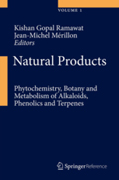
Handbook of natural products : phytochemistry, botany, metabolism: I - alkaloids II - phenolics III - terpenes
Ramawat, Kishan Gopal
Henry, Max
Merillon, Jean-Michel
The proposed volumes are intended to provide all the information regarding medicinal plants and phytochemicals at one place to researchers and teachers. Phytochemicals, by the strictest definition, are chemicals that are produced by plants. During the last two decades, many groups are actively involved in exploring the plants for useful metabolites that leads to identification of several useful curative agents and many promising molecules to fight/ prevent diseases, including carcinogenesis and stroke. When we talk about phytochemicals, there are also medicinal plants where not a single molecule is responsible for the observed properties. The volumes will contain contributions on phytochemicals and herbal extracts. A large number of natural products obtained from plants and microorganisms are used in cosmetic, drug, flavor and fragrance industries. Medicinal herbs and phytochemicals are selected on the basis of importanceof the compounds. Authors are selected by the contributions scientists made in the field. The present reference work will encompass the information about well established phytochemicals, biology and biotechnology of medicinal plants or their products, their biosynthesis, novel production strategies, demand anduses, metabolism and bioavailability. While there is a surge of information published in recent years on herbal medicine and their pharmacologic effects and books are available on each subject, researches who wish to keep a pace withthe rapidly developing field of natural products can consult this newly compiled handbook. All information about bioactive molecules and medicinal plants is available at one place. First reference work comprising all information about natural products in one place. Combines chemical as well as biological based information. Easy to find and easy to read because of repetitive and uniform chapter structure. INDICE: Volume 1: General biology. Part A: General biology. Part B: Biotechnology and genetic engineering. Part C: Classes. Alkaloids derived from ornithine. Alkaloids derived from lysine. Alkaloids derived from tyrosine. Alkaloids derived from Tryptophan. Alkaloids derived from anthranilic acid. Alkaloids derived from histidine. Alkaloids derived from animation reaction. Purine alkaloids. Part D: Methods of analysis. Part E: Pharmacology. Part F: Biological activity. Volume 2: Phenolics. Part G: Genetic engineering and Biotechnology. Part H: Methods of analysis. Part I: Classes – Occurrence, biosynthesis, structure and chemistry, distribution. Flavonoids (introduction). Flavans and proantocyanidins. Anthocyanins. Flavones and flavonols. Isoflavonoids. Minor flavanoids. Stilbenoids. Phenolic acids. Gallotannins and ellagitannins. Part J: Nutraceuticals and functional foods. Part K: Biological activity and bioavailability. Volume 3: Terpenes. Classes. Biosynthesis of Isoprene. Monoterpenes. Sesquiterpenes. Diterpenes. Triterpenes. Tetraterpenes. Polyterpenes. Terpenoids.
- ISBN: 978-3-642-22143-9
- Editorial: Springer Berlin Heidelberg
- Encuadernacion: Cartoné
- Páginas: 2000
- Fecha Publicación: 01/06/2012
- Nº Volúmenes: 1
- Idioma: Inglés
